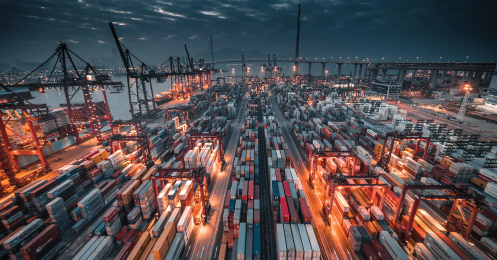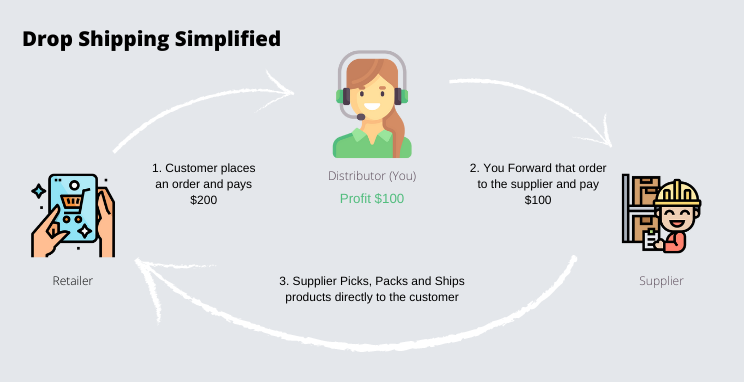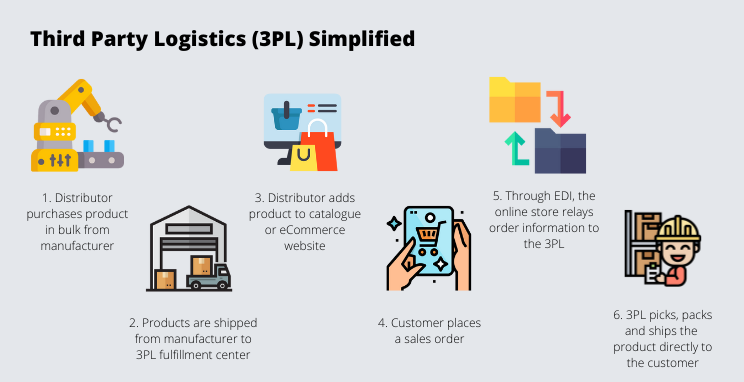Placing an order through Amazon is relatively simple. Once an online marketplace for books, Amazon now sells millions of products and with a click of a button on your smartphone, you could have an exercise bike sitting on your porch before the end of the day. It’s without a doubt that Amazon changed the game for eCommerce players and set high customer expectations for delivery. What’s truly fascinating is the fact that you could order toothpaste, some home décor, and a Whisky Decanter at 2 pm and it’ll all be delivered by 8 pm. If all those products are coming from different sellers, how does it all get shipped straight to the customer at the same time? The answer?
Amazon is the largest third-party logistics provider in the world and they allow for drop-shipping.
In today’s western society we often overlook the supply chain when ordering new stuff. We see what we like, we press a button and it’s ours! As a distributor yourself, when determining your order fulfillment process you have the option of housing your own inventory or outsourcing by using third party-logistics or drop-shipping. It’s not uncommon to confuse the two outsourcing options. Drop shipping is a method of business where individual purchases are shipped directly from the supplier to the customer, whereas a 3PL is strictly an order fulfillment service. This article will outline the differences to help you determine the best order fulfillment process for your business.
What is Drop Shipping?
The purpose of drop shipping is to enable retailers and distributors to sell niche SKUs without having to invest in inventory. Once you make the sale and receive a sales order you would then go to the supplier and create a purchase order. What’s important to understand here is that the distributors never actually own the product which means you do not have control over inventory levels.
What is a 3PL?
A 3PL or Third-Party Logistics is a business’ use of an external warehouse used for distribution and the purpose of a 3PL is to offer comprehensive and flexible order fulfillment services. The distributor (or retailer) purchases wholesale (bulk) amounts of product from the manufacturers - owns the product - and uses the 3PL to store the product and ship it to the customer. Therefore, once a sales order is created, purchased items are then shipped straight to the customer. Many distributors use a 3PL because they don’t have enough warehouse space themselves or because the location is closer to many customers which can help improve customer satisfaction.
Which is Better for Your Distribution Business?
As your business grows, your fulfillment needs will change, and you may find you will need the use of one or both outsourcing options at some point in time. Both 3PL and drop shipping are good for distributors who want to outsource the picking, packing and shipping process but depending on how you want to run your business one option will be better suited for you.
Drop Shipping vs 3PL: Drilling Into the Differences
If you’re a small distributor of a niche product with little capital and only a few SKUs – drop shipping is a great option. You don’t have to worry about stocking inventory for only a few SKUs and you don’t have to calculate landed costs since you don't own the product.
On the other hand, if you are a large distributor with many SKUs, warehouse management becomes a heavy task that you can outsource to a 3PL. 3PLs specialize in the picking, packing, and shipping process so if you’re running out of space or have recently expanded your SKU breadth, 3PLs are a huge help.
Product Ownership and Inventory Control
When you decide to drop ship a product, you only ever send a purchase order request to the supplier after you receive a sales order which means you don't own any product nor do you have any control over inventory levels. In this situation, you take care of sales, they take care of item production and inventory.
With a 3PL, think of this as an extension to your own warehouse. Although you may never actually touch the item, you do own it and when you integrate your ERP system with the 3PL's WMS, you will be able to see live inventory levels of the stock that you own. You take care of the sales and flow of inventory, they take care of picking, packing, and shipping of the product.
One Trusted Partner vs Many
With drop shipping, a single supplier could be selling to multiple distributors and when a product is in high demand, they might sell out or increase prices. As mentioned above, you will only purchase the product from the supplier once you receive a sales order so keep in mind varying stock levels and have backup suppliers if an order falls through.
When working with 3PLs take your time to do your research and get to know the business. You want a reliable partner, one where you can rest assured that the product won’t get damaged during storage or movement, and they are able to ship straight to the customer in a timely manner.
Product Lines
With drop shipping, it’s easy to take advantage of adding niche products to your catalog or eCommerce website. If the product doesn’t do well, you can remove it from your product lists and not have to worry about dead stock.
With 3PLs your product line is limited to what you purchase from manufacturers. Just like with your own warehouse, you will want to keep in mind SKUs that are not selling and taking up space. Creating a kit is a great way to clean up dead stock. Keep in mind, it will be more costly to test new products as opposed to distributors using drop-shipping.
Maintain Customer Loyalty
The COVID-19 Pandemic changed the game for eCommerce players and with the explosion of eCommerce and convenience, loyalty is at risk. 67% of consumers reported changing the way they shop due to the pandemic, making eCommerce and customer management important investments for companies. Since the pandemic has no border barriers, it’s having a big impact on the supply chain, especially in transportation. Products are taking longer to arrive, but you can support your customers through communication and product tracking. ERP is a robust software that can integrate with shipping couriers for your own warehouse or use EDI to get a report on the status of your purchase orders. This information can be at your fingertips for you to communicate with your customers on estimations for delivery.
To help determine the right software for your business needs download our Software Buying Guide.













